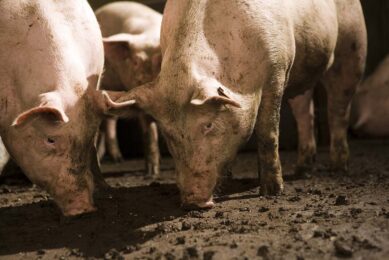How acidifiers improve gut health in pigs

It is common now to see organic acids or simply acidifiers being used as feed additives to replace antibiotic growth promotors. Acidifiers play an important role in pig gut health in many ways.
2 recent studies published in the Journal of Animal Physiology and Animal Nutrition (2020), and Animals Journal (2020), give an overview of key benefits of acidifiers in pig gut health. Their research focused on the benefits of organic acids on pig gut health as exerted through different modes of action in the feed and along the GIT in pigs. The modes of action include reduction of pH and feed buffering capacity, antimicrobial actions, beneficial modulation of microflora, the provision of energy, and factors influencing efficacy.
Organic acids can be classified into 3 main functional categories:
- short chain fatty acids (SCFA),
- medium chain fatty acids (MCFA), and
- tricarboxylic acids (TCA).
The common MCFA are lauric, capric, caprylic and caproic, while for SCFAs they are acetic, propionic, and butyric acids, and for TCAs they are citric, malic and fumaric. Other than these categories, there are a few organic acids such as benzoic, sorbic, and lactic acid that are widely used in food and feed preservation. Many acids are commonly used as salts of sodium, potassium, or calcium. The benefits of salts are less odour, easy handling during feed manufacture, less corrosive and high solubility in water compared to free acids.
Explaining feed buffering capacity
Here, the researchers remain us of the antimicrobial action of organic acids exerted through reduction of pH of the feed (reducing the risk of microbial contamination to the animal) and by direct growth inhibition of specific pathogenic bacteria such as Salmonella. The addition of organic acids to piglet diets is important since piglets lack the capacity to acidify their stomach content by hydrochloric acid (HCL), and also, gastric pH of piglets is kept high by the buffering capacity of the diet. Thus, the pH value in the stomach may stay high (usually pH 4-5) after feeding, leading to sub-optimal protein digestion and unfavourable pH for killing pathogens. Besides poor production of HCL, piglets lack sufficient lactic acid from lactose fermentation.
The researchers further highlighted that acidifiers improve protein digestion by reducing the buffering capacity of feed. High gastric pH impairs pepsin activation and function (optimal under pH 2 to 3.5), reducing the efficiency of protein digestion. Improved protein digestion means a healthier gut – undigested fractions that could act as substrate for pathogenic bacterial strains are reduced. This is particularly the case for undigested protein, which is linked to Clostridium perfringens, the bacteria responsible for necrotic enteritis. On the other hand, high pH increases the rate of gastric emptying, reducing the digestion time in the stomach. In addition, various organic acids (such as citric, formic, fumaric, and lactic acid) reduce environmental excretion of minerals such as calcium, phosphorus, magnesium, and zinc, by improving their absorption and retention. For example, citric acid increases calcium and phosphorus absorption through chelating calcium; this makes the phytate structure less stable and more accessible to phytase action.
Antimicrobial action
The researchers reviewed that although the antimicrobial activity differ between organic acids, by influencing the pH, most organic acids inhibit the growth of pathogenic bacteria. What they found is that the efficacy of acids against the coliform bacteria follows this order: benzoic > fumaric > lactic > butyric > formic > propionic acid. The proliferation of most pH sensitive bacteria (E. coli, salmonella, and C. perfringens) is minimised below pH 5 while acid-tolerant ones survive. This means organic acids promote the proliferation of beneficial bacteria which are acid-tolerant such as the Lactobacillus sp. and Bifidobacterium sp., creating the preferred microbiota-balanced or eubiotic state in the gut. Based upon the environmental pH and pKa values, organic acids in their undissociated form can diffuse across the bacterial cell membrane and dissociate inside the cell, releasing H+ ions and decreasing intracellular pH. This inhibits bacterial replication and growth, leading to bactericidal effects.
The efficacy of organic acids varies depending on the target organism. Gram positive bacteria (e.g., C. perfringens, Enterococcus spp., Streptococcus spp.) are mainly susceptible to MCFA, while Gram-negative bacteria (e.g., E. coli, Campylobacter jejuni, Salmonella spp.) are more sensitive to SCFA. The lipophilic nature of MCFA allows them to have a stronger antibacterial activity against Gram-positive species, whereas the presence of lipopolysaccharide in the Gram-negative cell wall confers resistance to these species. What is also observed is that SCFA in pigs increases the relative mRNA expressions of intestinal development-related genes, including IGF-1, IGF-IR, GLP-2, and GLP-2R, indicating the benefits of SCFA on gut morphology and development. Taking an example, butyric acid was seen to promote intestinal epithelial integrity as measured through its effects on increasing the relative mRNA expression of tight junction – offering an intestinal barrier function.
Modulation of microflora
Here the researchers further explained how organic acids modulate intestinal fermentation patterns. Taking for example, formic acid, the most studied; formic acid or its salts increases acetic acid and decreases lactic acid concentrations in both ileum and colon contents. This indicates a shift in the composition of intestinal flora and a modulation of microbial fermentations with more nutrients or metabolites (like acetate) available to the host.
Based on their antimicrobial mode of action, organic acids can inhibit the growth of undesired pH-sensitive microorganisms like Enterobacteriaceae, while promoting the proliferation of beneficial bacteria tolerant to lower pH. In this view, organic acids can be an optimal tool to control the dysbiosis characterised by coliforms overgrowth and Lactobacilli depression, typical of weaning time in pigs. SCFA reduce the pH and promotes the proliferation of beneficial bacteria; thus, offering a probiotic effect in the colon. What the researchers also found is that, besides individual organic acids, blends of organic acids including SCFA, MCFA, and acids salts increase the levels of acetic, propionic, and butyric acid produced by microbial fermentation of carbohydrates in the large intestine. Overall, organic acids have the potential to modulate the microflora populations and consequently microbial metabolites production along the GIT.
Figure 1 – Various acidifiers in animal nutrition.

Provision of energy
Organic acids can have a metabolic role by improving the intestinal mucosa trophism and modulating general metabolism, particularly for SCFA. In the large intestine of pigs, SCFA is rapidly absorbed by the colonic epithelium to play a pivotal role in the intestinal and general energy metabolism. Butyric acid is almost completely oxidised within the mucosa, serving as preferred energy source for the colonocytes, whereas propionic acid is collected by the liver where it is converted into glucose, and acetic acid is instead used by peripheral tissues. Sorbic acid added to weaning piglets increases growth performance through the modulation of lipid metabolism and the enhancement of insulin-like growth factor system, particularly relevant for the GIT development. In addition, the researchers point out that pigs can utilise fumaric acid as energy source with an efficiency close to that of glucose.
The researchers also gave an overview of the various applications of acidifiers in animal nutrition as highlighted in Figure 1.
Factors influencing efficacy
Several factors influence the efficacy of acidifiers; factors such as physical and chemical form (acid, salt, coated or uncoated), odour and taste, solubility, pKa value, minimum inhibitory concentration, site of action, dietary composition, and feed buffering capacity. Coating, for example, ensures the slow release of acids throughout the GIT, and curb the effects of odour.
 Beheer
Beheer





 WP Admin
WP Admin  Bewerk bericht
Bewerk bericht